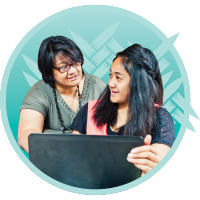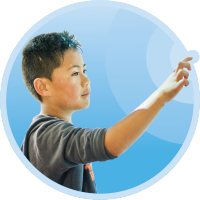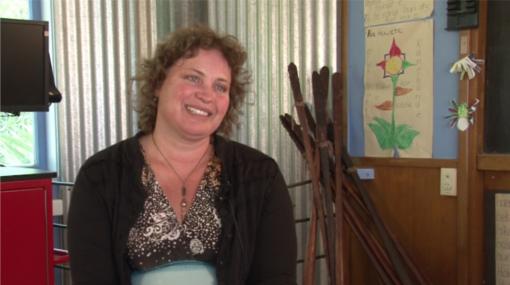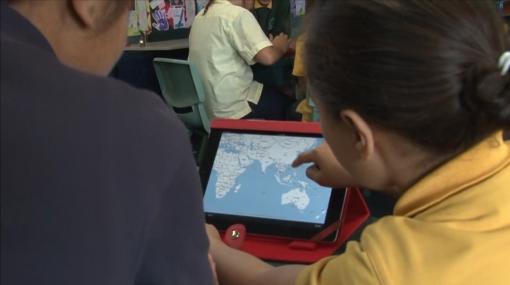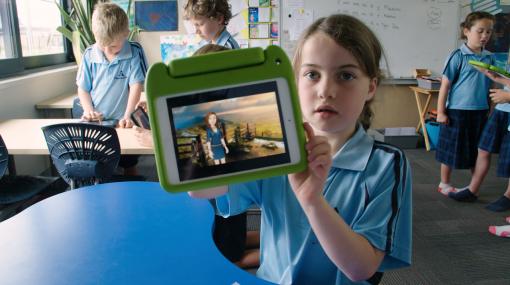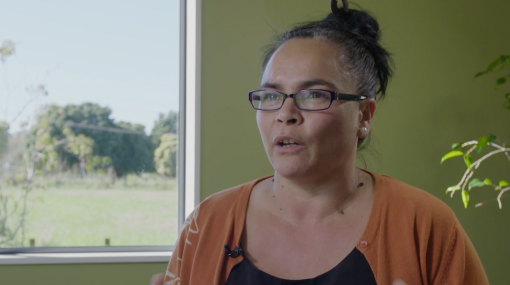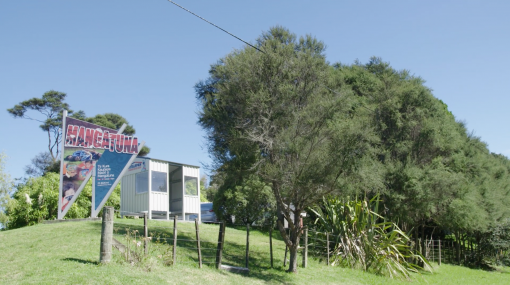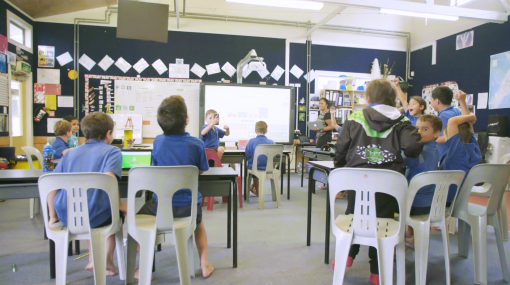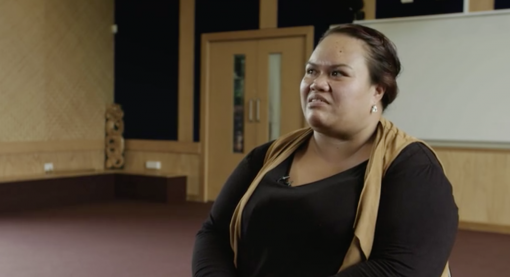Using digital technologies to support Māori learners
In traditional times Māori communities people with different areas of expertise worked together to solve problems and chart pathways forward. Te Rangitukutuku provides a framework for ākonga, whānau, and kura to plan and navigate their own e-learning journey.
Te ākonga – The students
"Māku e whatu, māu e tāniko"
"I will weave, you will fashion"
This whakataukī makes reference to the development of a child and relates to the guidance and support given to the ākonga while they carry out the learning to develop skills and understanding.
Planning to use digital technologies – questions to think about
- How do our ākonga view themselves as learners?
- What defines success for them?
- Are their learning experiences meeting their needs?
- What expectations do they and their whānau hold for their kura, kaiako and themselves?
He reo ākonga – Student voice
The responses our ākonga give to questions about themselves as learners are invaluable in the development of their curriculum and learning experiences.
Student views (archived), The New Zealand Curriculum Online
The types of questions that you might like to pose to ākonga can be grouped into three main categories:
- Big ideas: Thinking about the future, the things you would most like to do, and what succeeding at this might be like for you. What is important to you?
- Curriculum areas: What's your favourite subject and why?
- Your needs: What helps you learn? How do you learn new things?
Using digital technologies to support interactions between kaiako and ākonga
Technologies featured strongly in students' perceptions of the future, "Computers, there will be all computers, no books," said one student.
Student views (archived), The New Zealand Curriculum Online
The development of digital technologies means student interactions with kaiako and ākonga no longer need to be limited to verbal and written forms. Using student voice can progress the concept of ako, supporting teaching and learning relationships where the kaiako and ākonga share in the learning experience.
Video supporting differentiated learning needs
An example of this is the Visual exhibition project: Ko Wai Au , empowering Māori rangatahi who identify as Deaf to communicate with others through video, leading to a wider understanding of aspirations as young Deaf Māori.
Using online surveys
Online surveys such as SurveyMonkey , Google Forms , and Office Forms can provide students with a way to share feedback anonymously.
More information »
- Encouraging self-directed, empowered learners at Matakohe School – A video showing how Matakohe School have been investigating ways to further develop student voice.
It is important that ākonga are encouraged to present their thinking in a range of forums, where they can discuss their views, answer questions, and pose suggestions to teachers, leaders, family members, and fellow students.
Better than a professional? Students as co-contributors to educational design, 2010
Mā te ākonga anō tana ako e ārahi – Student-led learning
The role of whānau in student-led learning
The roles of ākonga, kaiako, and whānau in education are changing. A more flexible and open approach to teaching and learning environments can provide the opportunity for ākonga to lead their learning, and to support the education of others, including kaiako and whānau.
The tuakana/teina relationship, as an integral part of Māori society, provides a model for learning. An older or more expert tuakana helps and guides a younger or less expert teina. In a learning environment that recognises the value of ako, the tuakana/teina roles may be reversed at any time.
These learning experiences can be built with collaborative digital tools. For example, Google Drive and Microsoft Office 365 allow multiple users to contribute to the same documents, accessing learning spaces from any device, any place and at anytime.
Ākonga, kaiako and whānau can engage in ways that work for them as digital technologies support multiple means of representation, action, expression, and engagement.
Ako i roto i ngā hangarau matihiko - arā, te mahitahi o ngā ākonga me ngā kaiako.
Storytelling
Traditions of oral history are strongly woven into Māori culture. Supporting ākonga to develop oratory skills is an important focus for many kura. Digital technologies can provide new and exciting ways for ākonga to engage.
Drawing on their collection of digital stories, ākonga can develop their own digital portfolios of work, incorporating a range of digital media. Purpose-built apps allow kura to easily create digital spaces to share learning and connect with whānau. Accessible via mobile devices, these are being used where home computers and internet connectivity are barriers to whānau engagement.
Digital content can be shared online in a range of ways. Blogging provides a forum for ākonga to share their writing with an authentic audience. Receiving comments and feedback on their writing helps to develop a strong literacy foundation and multimedia storytelling can encourage reluctant writers to engage. Kura and classroom websites or blogs are a common choice. Social media sites are also being used to share with wider whānau, and those living outside of the rohe and overseas.
Whānau hui can be a good way to showcase learning. Supported by digital technologies these can become multimedia events, used to complement or even replace traditional reporting evenings.
E whakaatu ana tēnei ataata i te hononga a te hapori, ka tahi, mā te whakapapa, ka rua, mā te ipurangi, arā ko Pukamata.
Apps and other resources supporting students' learning – school stories
- Using Storybird to improve literacy skills
- Creating iBooks
- Improving oral language and writing with Photostory
- Using green screen to enhance learning of te reo Māori – Year 5 and 6 Students at Tautoro School, part of the Kaikohekohe Cluster, have been exploring using the green screening app to enhance their learning of Te Reo Māori.
Tāurungi matihiko – Digital citizenship
It is important for our students to be safe and successful digital citizens, and to use these online environments effectively and appropriately.
To achieve this, we clarify the learning purpose behind having ākonga connect, collaborate, and communicate online, and teach 21st-century skills of digital citizenship and cybersafety.
More information »
- Why teach digital citizenship? – Common Sense Educators Video.
- Digital Citizenship Resources
- Digital Citizenship Guidelines for Teachers
- Whakawhanui te Kaupapa, Quality Blog Commenting – Slides created Katie Nisbett (Grey Main School).
- Whānau Blogging Support – Multilingual blog (Māori, Niuean, English).
- Expressing tikanga and values online
Ko te ākonga te pūtake – Student-centered learning
Identity is a cornerstone of Māori society. Identifying and nurturing the gifts and talents of rangatahi is a practice held by many iwi and hapū.
Kaiako and kura can be supported by digital technologies to empower each learner to learn in a way that develops their individual strengths and abilities.
He whakarāpopotonga – Te ākonga
Ko te ākonga pūtake o te ako. I ia rā, i ia marama, i ia tau ka puta mai he mea hou, he wero hou mā rātou. Ko te mea nui kia āwhinatia, kia tautokohia ngā tamariki e tātou kia tū rangatira ai rātou i roto i tēnei ao hurihuri, i tēnei ao hangarau. Ahakoa ko wai, ahakoa nō whea.
References
- Hattie, John (2008). Visible Learning: A Synthesis of Over 800 Meta-Analyses Relating to Achievement . NY: Routledge. p. 392. ISBN 978-0-415-47618-8.
- Ngā Hangarau Matihiko i ngā Kura Ara Reo Māori – Māori-medium ICT Research Report 2016: Digital Technologies.
- Roberts, J., & Bolstad, R. (2010). Better than a Professional? Students as Co-Contributors to Educational Design . NZCER, New Zealand.
Tō mātou hapori – Our community
"He tangata ākona ki te marae tau ana"
"A person taught well on the marae will stand confidently (everywhere)"
This whakataukī is used to emphasise the importance of whānau/hapū/iwi/hapori in the education of our ākonga.
Building a partnership based on understanding and respect between teachers, parents, whānau, hapū, and iwi will support all Māori students to achieve success as Māori.
Community engagement – questions to think about
- Does our kura vision include the aspirations of our community?
- What resources and expertise might we draw on from within our community?
- How does our curriculum reflect our community?
- What might support us to connect with our community?
Ngā hononga ā-whānau – Whānau partnerships
Research shows that the kinds of relationships that are forged can have a significant effect on the outcomes for students.
By developing partnerships, kura are valuing and utilizing the expertise, skills and networks of whānau, connecting:
- parents with each other
- local community groups
- community members
- board of trustees.
He horopaki motuhenga – Authentic context
It is important that each kura be enabled to express their individual identity and that of its whānau, hapū, iwi. Te Marautanga o Āotearoa allows freedom for each kura to develop their place-based curriculum under local aspirations and values. Paul Enright at Logan Park High School in Dunedin explains that he found The New Zealand Curriculum allowed freedom to experiment, the same concept can be applied in Māori Medium settings.
In East Auckland Te Kura Kaupapa Maori o Puau Te Moananui-a-Kiwa is the only Māori language medium kura serving the communities of Glen Innes through to Ōrākei. Tumuaki Kātene Paenga describes how their kura are using technologies to reflect and affirm their identity.
He akoranga ā-takiwā – he hononga tōtika ki ngā hiahia a te iwi, he horopaki tūturu ā, ngā akoranga hōhonu anō hoki.
Te mahi ngātahi ā-kura – Collaboration across kura
Collaboration across kura enables leaders and teachers to work together and benefit from each other’s knowledge and experience, providing greater opportunities for students and improved student achievement.
Communities include formal Communities of Learning established as part of the Ministry’s Investing in Education Success initiative and informal networks.
Māori medium services and schools may form a Māori medium Community of Learning, or work with English medium services and schools. An example of an established community using digital technologies to share and connect is the Manaiakalani community of schools . United by a shared vision to lead future-focused learning, the Manaiakalani community of kura use cloud-based platforms to share curriculum and professional development resources, and individual expertise across the community of kura.
He whakarāpopotonga – Tō mātou hapori
E ai ki ngā kōrero ko te pūtake o te hapori ko te kura, ā, ko te pūtake o te tamaiti, ko tōna whānau, ka mutu, ko ōna hapū, ko ōna iwi.He mea whakahirahira te whanaungatanga i waenganui i te whānau o te tamaiti me te kura hei tautoko i a ia. Ko ētahi o ngā rautaki e whāia nei e tātou ko te mahi ngātahi, te whakarite horopaki motuhenga e hāngai ana ki te mōhio o te tamaiti, me te ako hoki i ngā pūkenga o te ao hangarau.
Te whakamārama i tō awhero – Clarify your vision
"Ko te ākonga te pūtake o te ako"
"The student is the centre of the learning"
This whakataukī is one of the key messages within Te Marautanga o Aotearoa (TMOA) and is a focus for designing curriculum and opportunities for your diverse range of ākonga. This underpins the need for a localised curriculum that is developed with your ākonga in mind.
The centre post of this Curriculum is founded on the aspiration to develop successful learners, who will grow as competent and confident learners, effective communicators in the Māori world, healthy of mind, body and soul and secure in their identity, and sense of belonging.
Te Marautanga o Aotearoa (p. 3)
Clarifying your vision – questions to think about
- How clear is your kura vision for your students?
- Do you have a graduate profile?
- How well does your kura gather and use information about the needs, wishes, and aspirations of students, whānau, and the wider community?
- How effectively does your kura inform parents about their children and communicate information about the kura?
- How well does the kura engage parents and whānau in the life of the kura?
- How well does the kura engage with and make use of community resources, agencies, and other educational institutions?
Te kōrero tahi me te whānau – Engaging whānau
Engaging whānau comes naturally to kura. By exploring the use of digital technologies with whānau, you have the opportunity to hear whānau voice and develop a shared understanding of the rationale for the use of digital technologies.
The effective use of digital technologies can also enhance this relationship by providing new and varied ways of connecting and engaging.
E whakaatu ana tēnei ataata i te hononga a te hapori, ka tahi, mā te whakapapa, ka rua, mā te ipurangi, arā ko Pukamata.
A lot of kura have run information evenings to showcase learning through the use of digital technologies.
Ngā awhero me ngā uaratanga – Vision and values
The name of your kura, a whakataukī or the local history is a starting point to identify the essence of your kura to localise your curriculum. This whakapapa provides a framework to support a strategic direction that is embedded in your community, whānau, hapū, and iwi, to achieve a high level of educational and cultural success.
In this guide we have chosen a whakataukī for each strand. This enables us to tell a story and guides us all to challenge our thinking. The invitation in the whakataukī “Ko te ākonga te pūtake o te ako” is to keep what’s important to the fore. In this case, our students and creating opportunities for them to succeed.
In a kura context this same approach of taking a whakataukī, the name of your kura or the local history (in agreement with the local hapū marae or iwi) can guide you to what is important and what you are all wanting to achieve. This will help you to make decisions and choose a specific pathway to achieve this.
He akoranga ā-takiwā – he hononga tōtika ki ngā hiahia a te iwi, he horopaki tūturu ā, ngā akoranga hōhonu anō hoki.
If the students and their aspirations are at the centre of your kura, how can you reflect this in your teaching and learning programmes? Digital technologies support and enhance opportunities for all to collaborate and share the aspirations and successes of your kura.
Graduate profile
Having kaiako, ākonga, whānau, iwi, and the wider community collaborating on the vision ensures all voices are heard and acknowledged. Encapsulated in this is a clear alignment to your te āhua o a tātou ākonga to enable your students to be successful. The graduate profile or te āhua o a tātou ākonga is a shared vision of what qualities and attributes a graduate will have when they leave. This shared profile will serve your kura well when you implement new initiatives as you will be able to relate them to your profile.
Ākonga can inquire into the meaning of the name of your kura and the local area. See examples and more information on the Living Heritage, Tikanga Tuku Iho website .
More information »
- Te whakakitenga, te whānau, te hapori
- Pakiwaitara Marau – Kura stories
- Living Heritage – A resource to support kura and young people to research and present their own web pages about their local community, family, and friends.
Te rangitukutuku – Māori medium e-Learning Planning Framework
The Māori-medium e-Learning Planning Framework supports kura and teachers to evaluate their e-learning capability. The framework provides kura and teachers with:
- a self-review tool to gather evidence about practice
- a tool to evaluate the effectiveness of e-learning programmes
- resources and services to support kura as they build capability.
The five whenu or dimensions are:
- Te Taiao Ako (Engagement beyond the classroom)
- Te Kanohi Mataara (Leadership and strategic direction)
- Te Ako (Teaching and Learning)
- Whanake Ngaiotanga (Professional Learning)
- Te Hangarau, Te Tūāpapa (Technologies and Infrastructure)
E kōrero ana a Merita Waitoa-Paki, te tumuaki o TKKM oTuia Te Matangi i Whakatū e pā ana ngā piki me ngā heke o Te Kanohi Mataara. Ki tāna, i te tīmatanga ko tētahi o ngā māharahara kia kaua e mataku ki tēnei mea te hangarau. 'Kāore he take kia mōhio ai i ngā mea katoa,' tana kī. 'Engari, me anga whakamua te kura, tūwherahia te hinengaro ki ngā akoranga rerekē.'
Aromatawai – Holistic picture of student
Within the learning context aromatawai is literally a way of focusing on the learner, what they can do, their learning journey and experience, the relationship between kaiako and ākonga, and how that information can support learning, instantly, and over time.
Rukuhia Rarangahia , (p 18).
Capturing information that provides a holistic picture of a learner’s progress is a crucial part in the process of teaching and learning. This could include academic goals and achievements, effort, pastoral information, and extracurricular participation and achievement. The information is valuable in that it can support learners to fulfil both individual and collective aspirations and expectations.
Aromatawai is not just about the reflections of the kaiako, it also allows for others, such as whānau, to have a say about the learning experiences and how they relate to learner achievement.
Within the Māori-medium education context the role of aromatawai serves two purposes:
- Within the kura, aromatawai can be used to determine how well students are learning.
- Within the wider community, aromatawai can be used to determine how well the kura is supporting community aspirations.
Rukuhia Rarangahia , (p. 18).
An effective approach utilises a range of sources and processes. Enabling learners to be involved in the whole learning process will enable learners to lead their own learning. Likewise, for whānau their involvement ensures all can take an active part in the learning conversations.
Staff at Te Kura o Kutarere talk about the change in students' attitude to learning that has occurred as a result of using Storybird in the writing process.
More information »
He whakarāpopotonga – Te whakamārama ake i tō awhero
E ai ki ngā kōrero, nā Tāne ngā kete o te wānanga i tiki atu. Ko te kete Tuauri, ko te kete Tuatea, ko te kete Aronui. Ka tiritiria, ka poupoua e ia ki a Papatūānuku, ki te ira tangata kia puta ki te whei ao, ki te ao mārama. Mai i a Tāne ki te ira tangata heke iho, heke iho e mau tonu ana ki ngā taonga i koha mai e Tāne. Ko te hanga o te tamaiti i ahu mai i tōna whakapapa. He ōrite te awhero o te tamaiti ki tērā o tōna whānau e mea nei, nō ngā kāwai rangatira, kia mōhio ai te tamaiti he Māori ahau, he tangata, he Atua!.
Te whakamahere me te whakamahi i ngā momo pūrere – Planning for and implementing devices
E tipu e rea mō ngā rā o tō ao
Ko tō ringa ki ngā rākau a te Pākehā
Hei ora mō te tinana
Ko tō ngākau ki ngā tāonga a ō tīpuna Māori
Hei tikitiki mō tō māhuna Ko tō wairua ki tō atua, Nānā nei ngā mea katoa
– Tā Apirana Ngata
Grow and branch forth for the days destined to you
Your hands to the tools of the Pākehā for the welfare of your body
Your heart to the treasures of your ancestors as adornments for your brow
Your spirit to god, who made all things
In this context, the tools of the Pākehā are digital technologies and all that comes with these, including knowledge and use of these tools.
Choosing devices – questions to think about
- What is driving the learning? Your vision or values? Or the latest technology?
- Are we exploring how digital technology can help gather and use formative assessment to improve learning and inform whānau?
- Has our kura assembled a coherent digital environment that supports our learning, teaching, assessment, and administration needs?
Te hanganga – Infrastructure
To support the planning and use of devices your kura needs a robust infrastructure in place. The considerations for this should inform your wider strategic plan, goals, and vision.
The BYOD and 1:1 Preparedness Checklist on our Hardware for learning page helps you reflect on your readiness for implementing devices across the kura. The in-depth checklist includes community and planning for both strategic direction and teaching and learning.
Tools such as the e-Learning Planning Framework/Te Rangitukutuku , can help you make sure that decisions are based on reliable information and that your plans include review and evaluation.
More information »
E kōrero ana a Moana Kake, Tumuaki o te kura kaupapa Māori o Te Pi’ipi’inga Kākano Mai Rangiātea e pā ana ngā hangarau matihiko me te hanganga i roto i te kura. Kia tū māia ngā kaiako me ngā tamariki.
Ngā pūrere BYOD – BYOD/1:1 devices
The driver for any decision on purchasing devices is the vision and values of the ākonga, staff, and the community. All decisions are driven by pedagogy including the purchase of devices. Access and affordability are secondary considerations to make the most impact with devices.
Ownership and funding models
Different kura are using different models to provide devices and enable the purchase of them.
The main ownership options are:
- school owned
- leased by parents but managed by the school or a trust
- owned by student/family/whānau, for example, Bring Your Own Device (BYOD) – this can be based on school specifications (e.g. BYOD iPads)
- mixed – school owns some devices and students own some; for example, your school may buy high end devices for a design suite in a BYOD school.
Many kura are setting up a "lease to own" arrangement for whānau. For example, the Manaiakalani Cluster is a community of collaborating kura who have overcome equity issues by setting up a lease-to-own arrangement for students (at around $3 to $4 per week).
If you are planning a model where parents are expected to fund devices, consider the approach you will take for those that cannot afford to purchase devices. Many schools have long-term payment schemes and hardship funding.
A good reseller should be able to listen to you to understand your situation and needs, and then provide useful advice and guidance about your procurement options. This will help ensure you are purchasing the technology that best meets your requirements. The reseller may also provide the services that are needed to get the technology properly set up and used.
Collaborating across a number of kura may enable you to negotiate a lower price.
More information »
Which device?
As well as the pedagogical considerations outlined above (decisions driven by aspirations and pedagogy), the following practical aspects may be useful when you start to look at which devices to choose:
- Mobility – devices being able to be used in different places.
- Portability – weight and size, especially if devices are being carried to and from kura.
- Communication, Connecting, Collaboration – working together physically or digitally.
- Simplicity – simple devices can allow more focus on the learning rather than the technology.
- Creativity – the ability for students to be making new things, working in different ways or creating new knowledge.
- Inclusiveness – will the devices support students with particular learning needs and support concepts such as Universal Design for Learning .
- Curriculum – aspects such as Numeracy, Literacy, or specific activities or tools that are necessary to access the curriculum.
One device may not meet all requirements and many kura have two or more types of devices depending on the needs and ages of their learners. For more information see Choosing the Right Device Guide .
Ngā pūtoi ako me ngā taiao ako – Pedagogy and learning environments
Many kura are thinking about implementing a vision and strategy around innovative learning pedagogies (ILP).
A learning environment may be understood to be the complete physical, social and pedagogical context in which learning is intended to occur. An innovative environment is one that is capable of evolving and adapting as educational practices evolve and change – thus remaining future-focused.
Innovative Learning Environments
The initiator of ILP is often new buildings, rebuilds or infrastructure capability through connections to the Network for Learning and/or SNUP/WiFi upgrades. It is important that any kura, before making any decisions/choices around their learning environment and other associated equipment costs, first asks fundamental questions and completes a thorough process before rushing in.
The fundamental question should be: Why ILP? Decisions must be driven by a vision for learning, graduate profile and practices that put the learner at the heart.
The Designing quality learning spaces page features a range of factors to consider, including the need for an overall vision and practical steps in writing a strategic plan. It includes a good range of resources that you should find useful.
Additionally, the Flexible Learning Spaces page which focuses on student learning is a resource that references the following when considering how to develop your learning environments.
Considerations for innovative learning environments
- What’s your vision for learning? How are the community involved in this vision?
- What kinds of teaching approaches, strategies, and learning activities can support students to achieve your kura's vision for learning?
- How can the environment be modified or developed to facilitate these approaches to learning and teaching?
- What professional learning development is needed to facilitate this development?
- What resourcing and considerations are needed for planning an innovative learning environment?
More information »
- TKKM o Ngāti Kahungunu o Te Wairoa – ArchitectureNow article.
- Innovative Learning Environments – Kura stories and information.
- Linking Pedagogy and Space – A comprehensive guide.
- Innovative Learning Environments – Ministry of Education kura and property focus.
Te whiwhinga – Procurement
Planning is a critical part of the procurement process and should be thought of as an ongoing procedure. A team approach will ensure the continuity of systems and processes.
Successful device programmes require a sustained investment that takes into account up-front and ongoing costs (both to the school and/or the parents). To ensure the sustainability of your technology procurements, we recommend that you:
- Create and maintain an asset register so you know exactly what you have:
- Include hardware, software/apps, licenses, warranties, and consumables such as ink and batteries.
- List the location, age, replacement date, warranty status, and serial numbers.
- Share responsibility for keeping the information up-to-date.
- Have a five-year plan that is reviewed annually and includes:
- evaluation of whether the technology is still worth maintaining
- how the technology supports the kura’s educational vision
- a summary of what expenses need to be budgeted as capital or operational costs
- evaluation of the procurement process.
Be clear about the intended vision and desired approaches to learning. Ensure you are able to justify your procurement in terms of how it will support and improve learning for your students.
More information »
He whakarāpopotonga – Te whakamahere me te whakamahi i ngā momo pūrere
E kī ana te whakataukī “Mate atu he tētēkura, ara mai he tētēkura.” Kia tōia e tātou tōna tikanga me tōna whakamahinga ki te ao e noho nei tātou ka pēnei tētahi o āna whakamahukitanga – whakamoea ētahi o ngā āhuatanga o mua, ā, torohia ngā āhuatanga hou o nāianei rangi kia ita, kia mau. Heoi anō, i runga i tērā whakaaro, anei ētahi kupu whakatūpato: ahakoa te hanga, te momo hoki o ngā āhuatanga hou, o ngā hangarau hou, kia kaua tātou e wareware i ngā mahi a ngā hangarau o mua. Nā ō tātou tūpuna aua hangarau i whakamahi i ngā tau maha kua pahure ake nei hei oranga mō tātou. Nō reira, whakamahia ngā mea hou hei oranga mōu me tō whānau, pērā i ō tātou tūpuna.
Te Ngaiotanga – Professional learning
"He toi whakairo, he mana tangata"
"Where there is artistic excellence, there is human dignity"
This whakataukī is used in reference to the arts. Tū Rangatira (2010) uses this whakataukī in a key focus area for leaders (mana tangata). This encourages leaders to recognise that relationships are critical to effective practice.
It terms of Whanaketanga Ngaiotanga (Professional Learning), when we excel, there is mana tangata. Within a learning environment, there will always be a need for professional learning and development for enhanced well-being.
Successful integration of technology in education is not so much a matter of choosing the right device, the right amount of time to spend with it, the best software or the right digital textbook. The key elements for success are the teachers, kura leaders and other decision-makers who have the vision, and the ability, to make the connection between students, computers and learning.
Students, Computers and Learning: Making the Connection, 2015
Professional learning and development – questions to think about
- Where are the voices of learners, staff, and whānau evident in the learning?
- How can you sustain ongoing professional learning?
- How is your vision, or how are your values represented in the use of digital technologies?
- Where can you see digital citizenship in your graduate profile?
- What roles do learners, staff, and whānau play to create confident and capable ICT users?
Hei tautoko i te whānau – Supporting whānau
Communicating with whānau from the outset will not only strengthen this partnership but also involves them in the process of implementing devices. As whānau are part of the kura vision, developing a shared understanding of how digital technologies can support the vision and lead to better outcomes is essential for success.
Begin by using kura stories and examples from Enabling e-learning kura. Over time, you can create your own similar stories to share.
Finlayson Park School work with the philosophy of doing more for many with less. They have set up a free after-school study centre for students to allow them access to computers and the Internet as many families don't have Internet access from home.
More information »
- Te Taiao Ako
- Parent technology sessions – video.
Te ngaiotanga – Professional learning
Making the shift in thinking to change practice is an ongoing process and important for supporting your teachers as they explore how to work together to benefit student learning outcomes. Creating a professional learning environment for staff to share their experiences of using digital technologies has been a successful strategy for many kura as staff help each other work.
This can be achieved through:
- pakirehua
- internal PLD (just-in-time targeting needs)
- external PLD (avoid echo chamber, etc.)
- tech savvy students
- help systems and processes for support.
Te Rangitukutuku: Whanake Ngaiotanga – Whanake Ngaiotanga/Professional learning is one of the five dimensions of the e-Learning Planning Framework. This is designed to support schools to develop their e-learning capability across the five dimensions. The Whanake Ngaiotanga page contains school stories and examples to support Kura Kaupapa Māori.
E kōrero ana a Merita Waitoa-Paki, te tumuaki o TKKM oTuia Te Matangi i Whakatū e pā ana te whanake ngaiotanga a ngā kaiako. I ngā rangi pouako he wā te whakangungu mō te āhuatanga ako-e. Ko te mahi ngātahi te tino whainga o te mahi, kia kaua tētahi e ārahi, engari mā te katoa ngā mahi e ārahi.
Pakirehua – Inquiry
Pakirehua is an inquiry process to gather evidence based on your practice to achieve successful outcomes and meet the learning needs for your ako. Through pakirehua, we gather stories that will inform our practice and lead to future success. The following resource outlines pakirehua to support kura.
Ka whakamārama a Tammy Gardiner rāua ko Marama Reweti-Martin i te pakirehua mai i te tirohanga Māori. Hei tā rāua me whai take te pakirehua hei āwhina i ngā kaiako ki te whakapiki ake i o rātau mahi whakaako. He huarahi te pakirehua e hono ai ngā mahi akoako ki ngā kōrero o te hunga tangata whenua.
Refer to the Pakirehua page for more information.
Te tāurungi matihiko me te haumaru ā-ipurangi – Digital citizenship and cybersafety
As digital technologies are now being used more and more, being a confident and capable user is important. By engaging in digital citizenship and cybersafety on an ongoing basis, all your learners, staff, whānau, and community can be clear about what is expected of them in an online environment.
Co-constructing agreements with students and your community will go a long way in preparing everyone to use devices safely. Linking this to your vision or graduate profile will help you to identify what a responsible digital citizen will look like at your kura.
He whakarāpopotonga – Te Ngaiotanga
“Whaia te iti Kahurangi, ki te tuohu koe me he maunga teitei”. Ko te ngako o te whakataukī nei e akiaki ana i te tangata ki te whai i ōna moemoeā, kia piki ki te tihi o ōna tino hiahia, ā, me maunga teitei e kore ai. Mā te aha e tutuki ai e te tangata ōna moemoeā? Mā te pukumahi, te rangahau, te pakirehua, te kōrero, te whakarongo, me te titiro.
Filter by: Māori Te reo Māori
Sorry, no items found.
